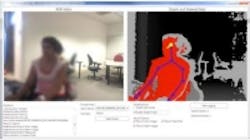Vision system monitors patient-physician interactions
"Lab-in-a-box," as it has been dubbed by researchers from the University of California, San Diego’s (UCSD) Computer Science and Engineering (CSE) department, is avision and data collection system designed to analyze a physician’s behavior and better understand the dynamics of the interactions of the doctor with the electronic medical records and the patients in front of them.
MORE ARTICLES
3D facial imaging aids early autism detection
Vision helps robot perform physiotherapy
Medical Imaging: Micro-tomography system generates 3D images of teeth
The project—which has an ultimate goal of providing useful input on how to run a medical practice more efficiently—was developed as a result of the fact that, quite often, physicians pay attention to information on a computer screen, rather than looking directly at the patient, according to UCSD.
"With the heavy demand that current medical records put on the physician, doctors look at the screen instead of looking at their patients," said Nadir Weibel, research scientist in the CSE department. "Important clues such as facial expression, and direct eye-contact between patient and physician are therefore lost."
Lab-in-a-box consists of a set ofsensors and tools that will record activity in the office. A depth camera from a Microsoft Kinect is used to record body and head movements, while an eye tracker from SensoMotoric Instruments follows where the physician is looking. Images are transferred to a PC-based frame grabber from Epiphan. In addition, a 360° microphone records audio in the room and the Lab-in-a-box also interfaces with the physician’s workstation, where it can keep track of keyboard strokes, movements of the mouse, and pop-up menus that may divert the doctor’s attention.
Perhaps most important, however, is the accompanyingsoftware that is designed to merge, synchronize, and segment data streams from the various sensors, which provides insight on which activities may led to distractions for the physician. For example, lots of head and eye movement would suggest that the doctor is multitasking between the computer and the patient, according to Weibel.
The Lab-in-a-box team will compare data from different settings and different types of medical practices in order to identify the distraction-causing factors. Their findings may also help software developers write less-disruptive medical software, suggests theUCSD press release. Furthermore, the team envisions deploying the toolkit permanently into physicians’ offices to provide real-time prompts to warn that he/she may not be paying enough attention to a patient.
"In order to intervene effectively, we need to first understand the complex system composed by patients, doctors, and electronic medical record in depth, and this is what our study will finally yield," said Weibel.
The Lab-in-a-Box has been developed as part of Quantifying Electronic Medical Record Usability to Improve Clinical Workflow (QUICK), a running study funded by the Agency for Healthcare Research and Quality (AHRQ) and directed by Zia Agha, MD. The system is currently being deployed at the UC San Diego Medical Center and the San Diego Veterans Affairs Medical Center and will run through June 2016.
View theUCSD press release.
Share your vision-related news by contactingJames Carroll, Senior Web Editor, Vision Systems Design
To receive news like this in your inbox,click here.
Join ourLinkedIn group | Like us on Facebook | Follow us on Twitter| Check us out on Google +
About the Author

James Carroll
Former VSD Editor James Carroll joined the team 2013. Carroll covered machine vision and imaging from numerous angles, including application stories, industry news, market updates, and new products. In addition to writing and editing articles, Carroll managed the Innovators Awards program and webcasts.
